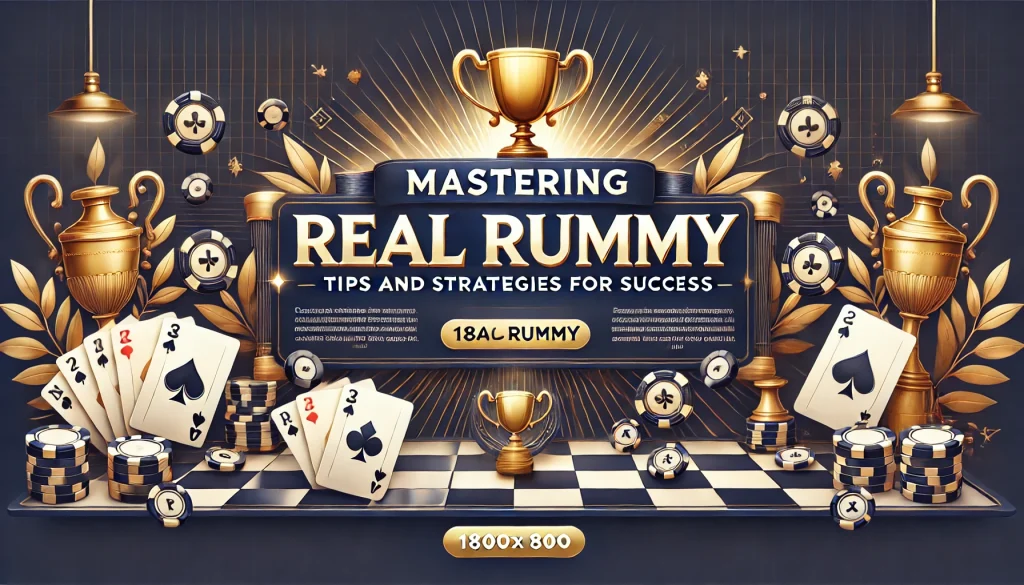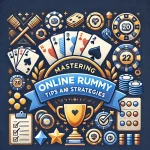Description

Real Rummy: A Complete Guide Since its combination of skill, strategy, and a little bit of luck, real rummy has captured the attention of players worldwide. Fundamentally, the game is about using a standard deck of cards to form sets and sequences. The goal for players is to merge their cards into legitimate combinations, which can be three or four cards of the same rank (sets) or three or more consecutive cards of the same suit (sequences).). By combining all of your cards, you can be the first to declare victory while simultaneously monitoring the moves of your opponents. Anybody who wants to succeed at Real Rummy must comprehend these basic principles.
Depending on the variation being played, each player is dealt a certain number of cards in this game, which normally has between two & six players. One face-up card initiates the discard pile, while the remaining cards form a draw pile. Each player draws from the draw or discard pile in turn, then discards one card. Until the player successfully melds every card in their deck, this cycle keeps going. Knowing how the game works is essential, but it’s also critical to understand the subtleties of strategy & psychology that can have a big impact on how each round turns out.
A winning mindset in Real Rummy includes a more comprehensive psychological approach to the game than just knowing the rules. Players need to develop endurance & patience because the game frequently takes unexpected turns. In both winning & losing streaks, it’s critical to remain composed. A player with emotional control will avoid rash plays that could endanger their chances of winning and instead make more well-considered choices.
Players are able to concentrate on their strategy instead of becoming preoccupied with the results of each turn because of this mental toughness. It also entails accepting flexibility in order to cultivate a winning mindset. Depending on the cards dealt & the tactics used by opponents, every Real Rummy game offers different difficulties. A successful player must be able to change tactics quickly and know when to play defensively or aggressively.
This versatility not only improves gameplay but also makes it more difficult for opponents to guess your next move. Players can greatly increase their chances of winning at Real Rummy by cultivating a mindset that values both patience and adaptability. It takes both strategic card selection and foresight to build a strong hand in Real Rummy.
Concentrating on creating sequences early in the game is one successful strategy. Because sequences give you more options for card combinations, they are typically simpler to finish than sets. For example, drawing a 4 or 7 can assist you in finishing your sequence if you have a 5 & 6 of hearts. Since you can frequently predict which cards will be more useful based on what you already have, prioritizing sequences can also help you decide which cards to keep and which to discard. It is essential to pay attention to the cards your opponents are picking up and discarding in addition to sequences.
You can learn a lot about their tactics from this observation, which will also assist you in choosing which cards to keep. Keeping cards that could impede an opponent’s progress might be a good idea if you observe them routinely selecting cards from the discard pile that could finish a set or sequence. You can create a hand that not only advances your goals but also thwarts those of your opponents by choosing your cards proactively & paying attention to what they are doing.
One crucial element of Real Rummy that has a significant impact on the game’s outcome is the discarding and picking up of cards. Players should always think about how their actions might affect their opponents when discarding. It’s frequently a strategic error to discard a card that could aid an opponent in finishing a meld. Instead, while still moving closer to your own melds, try to discard cards that are less likely to be helpful to other people. Discarding a card from a suit that your opponents appear to be collecting, for instance, can be beneficial if you have several cards of different suits.
In contrast, players should consider the implications for their opponents as well as their own needs when picking up cards. When selecting a card from the discard pile, think about how it will fit into your hand and whether it could unintentionally help an opponent finish their melds. Also, always watch the draw pile; sometimes it’s better to wait for a better card than to grab something that might not be a good fit for your strategy.
Gamers can greatly improve their gameplay by becoming proficient at picking up and discarding cards with purpose and foresight. Jokers and wild cards are effective Real Rummy strategies that have the ability to significantly change the game’s dynamics. These cards are very useful for finishing sets or sequences because they can be used in place of any other card. But how well you use them in your hand will determine their actual potential.
If you possess a joker, think about utilizing it to its fullest potential by blocking an opponent’s possible melds or finishing a high-value meld. Utilizing jokers sparingly is crucial because relying too much on them can result in lost chances to create more conventional melds. Also, it’s critical to monitor the number of jokers remaining in play as well as how your opponents are using them.
It could mean that your opponent is almost finished with a strong hand if you see that they have picked up a joker. It might be prudent to modify your approach in these situations, maybe playing more defensively or concentrating on finishing your own melds before they declare victory. Players can get a big advantage in Real Rummy by knowing how to use jokers efficiently and how to predict when others will use them. The ability to spot trends in your opponents’ gameplay is one of the most important Real Rummy skills. Every player is different; some might prefer forming sets to sequences, while others might rank particular suits or ranks higher depending on their starting hands.
By keeping an eye out for these trends during the game, you can learn what cards they might be holding & what tactics they are probably using. You can choose which cards to keep or discard with greater knowledge. Also, leveraging these trends entails not just identifying them but also strategically utilizing them to your benefit. For example, it might be a sign that an opponent is attempting to create particular melds if you observe them regularly discarding high-value cards from one suit while gathering others from other suits.
Using this knowledge, you can stop them from moving forward by keeping cards that could finish their sets or sequences. You can use your opponents’ patterns as opportunities for your own success if you keep an eye on their actions and modify your plan as necessary. In Real Rummy, determining when to declare victory is just as important as creating a winning meld. If your hand isn’t strong enough in comparison to other players at the table, making a declaration too soon could result in lost chances to maximize points or even defeat.
When making this crucial choice, it’s important to evaluate both your own hand and what your opponents might be holding. Declaring may be beneficial if you think you have created a powerful meld with little danger from your opponents’ hands; if their possible melds are unclear, it may be better to wait. Throughout the game, strategic planning is required to create a winning meld. Consider each card’s contribution to your overall strategy as you draw and discard cards. Choose sets & sequences that will maximize points while lowering risk; this usually entails balancing them according to your resources and what you see in other players’ gameplay.
When new cards enter the game, it’s critical to be able to modify your meld strategy. This will not only help you declare when it’s appropriate, but it will also guarantee that you do so with confidence in your winning hand. Advanced strategies like bluffing & misdirection can greatly improve your Real Rummy gameplay. Deception can lead to unexpected wins even though the main focus of this game is skill & strategy.
For example, you might give opponents the impression that you are pursuing entirely different melds if you routinely discard particular suits while covertly keeping valuable cards from those suits. Their decisions may be based on incorrect assumptions about your hand as a result of this deception. However, bluffing successfully necessitates careful execution; if opponents notice too soon, going overboard can backfire.
Achieving a balance between strategic deception and real gameplay is crucial because leaving your opponents wondering about your true motivations will keep them guessing. Also, observe their response; if they appear unduly defensive or hostile in light of your behavior, it might be a sign that your bluff is successful. In Real Rummy, players can increase their chances of outwitting opponents and add an exciting layer of complexity to their strategy by becoming proficient in the art of bluffing and misdirection. In summary, mastering Real Rummy entails comprehending its basic mechanics & creating strategic approaches that combine tactical gameplay with psychological components.
Every element plays a vital role in winning this captivating card game, from effectively using wild cards and constructing strong hands to identifying opponent patterns and using bluffing strategies. Players can hone their skills and have endless hours of competitive fun at the table with practice & commitment.


